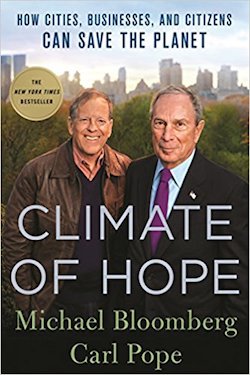SEJournal Online is the digital news magazine of the Society of Environmental Journalists. Learn more about SEJournal Online, including submission, subscription and advertising information.
BookShelf
“Climate of Hope: How Cities, Businesses, and Citizens Can Save the Planet”
By Michael Bloomberg and Carl Pope
St. Martin’s Press, $26.99
Reviewed by Jim Motavalli
A relative of mine made a comfortable living helping big clients comply with Clean Water Act regulations during the Carter administration. But her income plummeted and her company went into bankruptcy during the Reagan years.
Why? Those same clients said the federal water rules weren’t being enforced, so why bother with expensive consultants?
 |
We’re at a similar historical point now, and in the face of that reality comes the ultimately uplifting book “Climate of Hope” by ex-New York City Mayor Michael Bloomberg and former Sierra Club chief Carl Pope. It’s hopeful because it concludes that, despite partisan obstacles, we have made progress in fighting the planet’s warming.
Despite a global increase in economic activity and population, greenhouse emissions are essentially flat — something the authors point out wasn’t supposed to happen for decades.
Cheap natural gas helped, but so did the smart initiatives outlined here.
The book is filled with bipartisan success stories: Republican mayors who realize that nature isn’t either red or blue; countries that are replacing their coal-fired power plants with cleaner alternatives; cities that are “taking the wheel” to get commuters out of cars and into public transportation; and regions that are reforming farming practices to reduce waste and soil-damaging cultivation (while cutting emissions and increasing yields).
“We will never win hearts and minds simply by trying to convince people to stop eating meat or give up their cars, but we can win them by demonstrating how fighting climate change is good for them, their families and their communities,” Bloomberg and Pope write in the concluding chapter.
The book benefits from Bloomberg and Pope being long-time leaders who can describe how programs they championed actually worked.
Bloomberg can point to his sensible handling of Hurricane Sandy, and to far-reaching, green-themed PlaNYC (which continues in the administration of current Mayor Bill de Blasio under another name).
Pope can justifiably be proud of the Sierra Club’s Beyond Coal initiative, which was timed to stop major plant construction spearheaded by then-Vice President Dick Cheney.
Stepping into the vacuum of federal action
Many of the initiatives described here will be familiar to SEJ readers, but enough of them are novel and exciting to make the book worthwhile.
For example, Niger, one of the poorest countries in the world, is making major progress in ecosystem restoration. American car fleets averaged 35.6 mpg by 2014. India, despite its challenges, is committed to increasing its forest cover from 21 to 33 percent. And through green bonding, Johannesburg, South Africa raised $143 million for sustainability initiatives.
As other books have done, “Climate of Hope” points out that cities, states and regional compacts can sometimes step into the breach when there’s a vacuum in federal leadership.
That may well be the case in the next few years, as climate campaigners work around Washington. The authors apparently finished writing just after President Donald Trump was elected, so they were still holding out hope that he wouldn’t roll back the U.S. commitment to the Paris Accord, to fuel economy standards, the Clean Power Plan and regulating methane.
Well, now we know. Still, the book makes a strong case that the international forces combating climate change are making progress, and that technological breakthroughs will help us even more in the near future.
Bloomberg and Pope are technocrats; they like what Elon Musk and his ilk are doing. They’re also realists who know the climate will get worse before it gets better, and that’s why they devote a fair number of pages to protecting areas as disparate as southern Louisiana and New York City from rising waters.
If the book has a flaw, it’s in emphasizing progress over the concurrent backwards steps.
I’m not sure, for instance, that we’re seeing “Oil’s Twilight” just yet, and lots of dirty fuel is still being burned. Even as China commits to renewable energy and competes vigorously in the solar market, it’s also building many new coal plants.
And low oil prices are selling SUVs like never before and strangling fuel economy gains. That’s why automakers want to roll back CAFE. The book asserts that green cars dominate at today’s auto shows, but the last few I attended showcased luxury crossovers and big SUVs.
But these aren’t fatal concerns. Bloomberg and Pope believe market forces are on our side, and are stronger than ideology. Fighting the warming of our one and only planet is, after all, good business.
Jim Motavalli writes for “Car Talk” at National Public Radio and is the author of eight books, including “Feeling the Heat: Dispatches from the Frontlines of Climate Change.”
* From the weekly news magazine SEJournal Online, Vol. 2, No. 28. Content from each new issue of SEJournal Online is available to the public via the SEJournal Online main page. Subscribe to the e-newsletter here. And see past issues of the SEJournal archived here.













 Advertisement
Advertisement 



